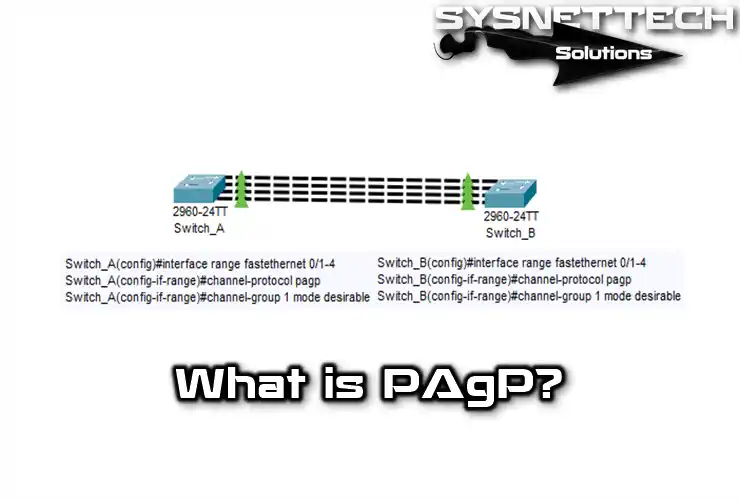The Port Aggregation Protocol (PAgP) is a proprietary technology developed by Cisco. It facilitates the seamless establishment of EtherChannel connections. This technology combines physical links between switches. It creates a single logical link, providing increased bandwidth and redundancy. Furthermore, it enhances network performance significantly.

What is the PAgP Protocol, and How It Works?
When configuring EtherChannel using PAgP, devices’ ports send packets to each other. This negotiation aims to create a channel.
When we specify PAgP-compatible Ethernet ports, we group them in an EtherChannel structure. We add this structure as a single port in the Spanning Tree protocol.
When enabled between network devices, the protocol sends packets every 30 seconds. It checks configuration consistency and manages failures between switches. Additionally, it handles added connections.
Creating an EtherChannel group ensures that all ports have the same type of configuration.
Also, all ports of the created group must have the same speed, duplex setting, and VLAN information. Therefore, a change made to one of the ports in a group will affect the other ports in the group.
This technology detects configuration on both devices. It helps create EtherChannel by ensuring compatible connections.
PAgP Modes
Desirable
When operating in desirable mode, the interface sends packets to establish communication. In this process, negotiation occurs between active interfaces. They exchange information to develop a suitable connection.
Auto
In automatic mode, the interview process includes a passive interface. It responds to packets received over the interface but does not initiate the connection.
How Does PAgP Work?
The PAgP modes configured on devices in the network must be compatible on both sides. If one side sets Auto mode, the interface deactivates. At the same time, the other party tries to establish the EtherChannel connection.
The conversation will never start if you set the other party to Auto mode. In this case, the EtherChannel channel does not occur. Suppose you turn off all methods without a command between switches in the network. In that case, it will also break the EtherChannel channel.
The On mode manually adds the device’s interface into a group without any conversation with the other device. However, the other device also requires the configuration of the On mode.
Configure PAgP for only one device, on the other hand. Otherwise, you will not be able to establish any connections.
Features of Port Aggregation Protocol
The main features of the port combination protocol are;
- Because it is a Cisco proprietary protocol, it does not work with other brands.
- It is like the LACP protocol’s working structure but is incompatible.
- The ports that make up the channel send packets.
- It only creates a connection with ports that have the same characteristics.
- It only includes ports with the same VLAN or trunk connection in the created channel.
- When one of the ports that make up the channel changes, it changes the settings on all ports belonging to the track.
How to Configure PAgP?
PAgP only works between Cisco-developed devices. However, if you aggregate with a different device brand in your network, you should use the IEEE 802.3ad (LACP) protocol.
To enable PAgP between two Cisco Switches:
- PAgP typically runs between ports configured as access or trunk. So make a note to collect the ports you specified.
- Provide a management connection to the Cisco device, such as a console or Telnet / SSH.
- Switch to Configuration mode with the help of the Enable command.
- Perform the following steps to configure the interfaces for which you want to create an aggregate:
a) If you are going to combine ports serving different VLANs, configure the trunk port:
interface GigabitEthernet0/1
switchport mode trunkb) If you are going to combine connections over the same VLAN, configure the access mode:
interface GigabitEthernet0/1
switchport mode access- Next, enable PAgP on the GigabitEthernet ports of both Switches:
interface GigabitEthernet0/1
channel-group 1 mode desirableIn Desirable mode, you can aggregate any PAgP-supported ports. However, you should use the “auto” command if the opposing device’s port only supports PAgP.
- Likewise, configure the GigabitEthernet0/2 ports of the Switches with the command below:
interface GigabitEthernet0/2
channel-group 1 mode desirable- Finally, create a virtual interface called Port Aggregation Group (PAG). Then, aggregate the connections using this interface.
interface Port-channel 1 # Here is the PAG number (e.g., 1)- Save the configuration and check that PAgP is working correctly:
show running-config # To check the correctness of the configuration.
show etherchannel summary # To see the EtherChannel summary.Related Articles
1) What is LLTD?
2) What is AFT?
3) What is LLDP?
4) What is the CDP Protocol?
5) What is the NetFlow Protocol?



